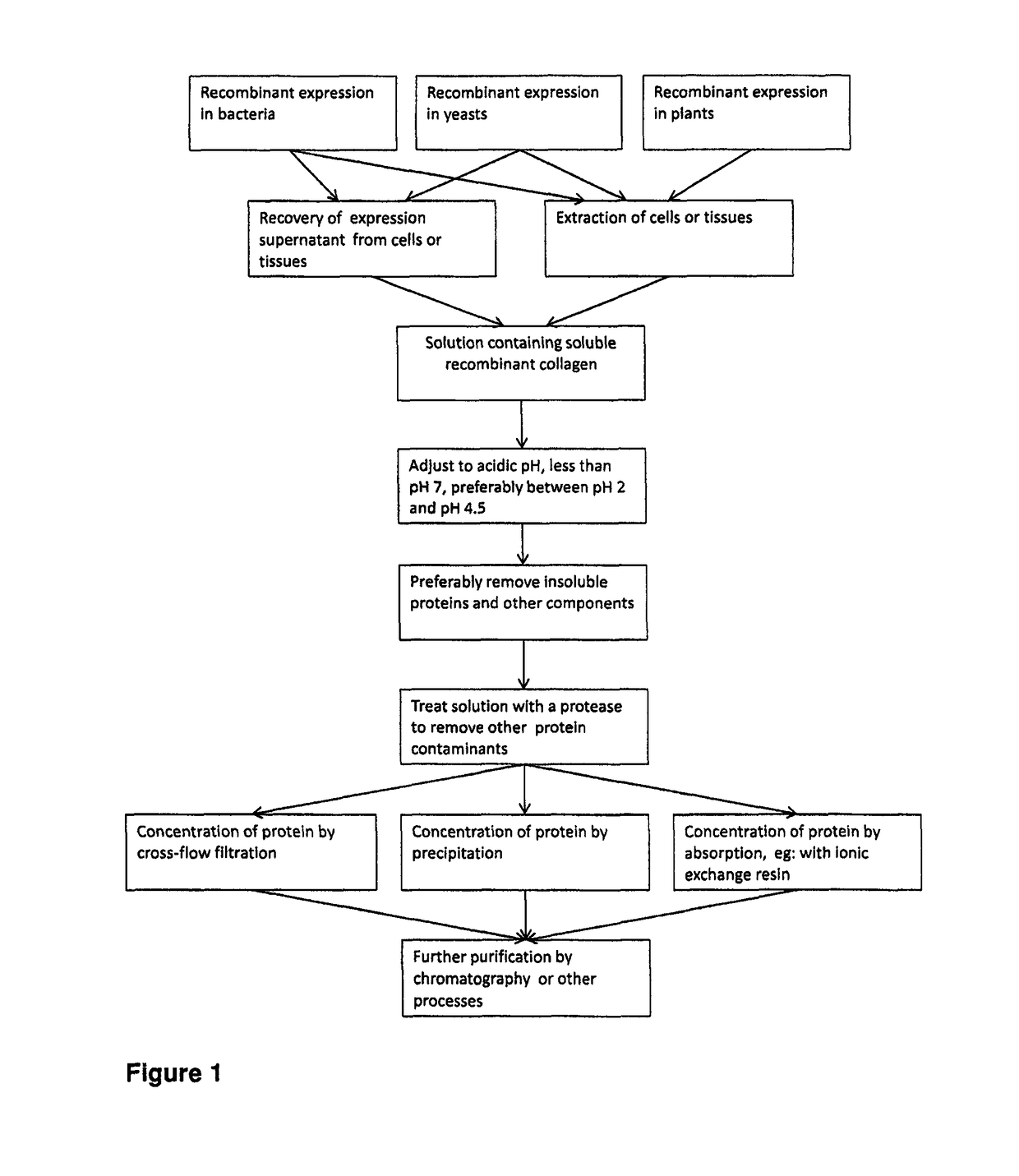Purification of triple helical proteins
a technology of triple helical proteins and collagenlike proteins, applied in the direction of bacteria peptides, peptide sources, peptide sources, etc., can solve the problems of complex yeast systems, limited design and modification of extracted collagens to enhance or change specific biological properties, and limited animal-derived collagens. achieve the effect of small molecular weigh
- Summary
- Abstract
- Description
- Claims
- Application Information
AI Technical Summary
Benefits of technology
Problems solved by technology
Method used
Image
Examples
example 8
Repeats of a Fragment of Human Type III Collagen
[0160]The template for the PCR reactions was based on cDNA Clone MGC:39848 (Image 5405119) (ATCC, Manassas, Va.), which contains the human COL3A1 gene, with limited base changes introduced that do not change the amino acid sequence but decrease the possibility of secondary structure formation.
[0161]PCR products were separated by electrophoresis and excised bands were extracted using a QIAquick Gel Extraction Kit (Qiagen).
[0162]The oligonucleotides used for PCR generation of three separate fragments for cloning were:
[0163]
M G A P G A P G(SEQ ID NO: 47)EcoRI up5′-CCG G / AATTC GGT GCC ATG GGT GCT CCA GGT GCT CCA GGT -3′(SEQ ID No: 31)EcoRI a g p p g p p(SEQ ID NO: 48)Xmal down5′-TCCCC / CCCGG AGC ACC TGG TGG ACC TGG TGG AC-3′(SEQ ID No: 32)Xmal D A G G K G D A G(SEQ ID NO: 49)Xmal up5′-TCCC C / CCGGG GAT GCC GGT GGT AAG GTT GAC GCT GGT-3′(SEQ ID No: 33)Xmal G p p g p p g(SEQ ID NO: 50)BamHI down5′-C...
example 9
uman Type I Alpha 1 Chain CB3 Fragment
[0166]The DNA sequence for the CB3 fragment of the human type I collagen alpha 1 chain was obtained from the data provided in the National Center for Biotechnology Information database (National institutes of Health, Bethesda, Md. 20894, USA) as record # GenBank: Z74615.1. The sequence was modified by adding a C-terminal His6-tag (SEQ ID NO: 46) and a termination codon and had 5′ NdeI and 3′ EcoRI and HindIII restriction sites added, making the construct suitable for inserting into the pCold IV vector. The stability of the triple helical protein produced from this DNA means that all manipulations must be performed at 4° C. The construct was synthesised (GeneArt® Gene Synthesis, Regensburg. Germany) with conservative substitutions that retained the original amino acid sequence while optimising for expression in a desired host system, E coli.
[0167]The final sequence construct is described in SEQ ID No: 39
[0168]
example 10
Chimera Made from Segments from Human Collagen Type I and Type III Chains
[0169]Human collagen type I, alpha I c-DNA with ATCC accession number 95498 and human collagen type III, alpha I c-DNA with ATCC accession number 95502 were used in the production of chimeric DNA.
[0170]Initially, 10 ng of c-DNA encoding the collagen I and III genes was transformed into 50 μl of the E. coli host strain, using the heat shock method at 42° C. Colonies resistant to ampicillin were recovered and grown overnight in 150 mls of YT media.
[0171]Restriction digests of parental clones were carried out and were then analysed on 1% agarose gel electrophoresis, and collagen bands isolated and purified. Vector and purified insert preparations were ligated using the T4 DNA ligase kit (Invitrogen). The ligation mixture was then transformed into Top10 cells and plated onto ampicillin selective media. Colony PCR was used to detect clones that contained the engineered chimeras. PCR products containing potentially e...
PUM
| Property | Measurement | Unit |
|---|---|---|
| temperature | aaaaa | aaaaa |
| temperature | aaaaa | aaaaa |
| temperature | aaaaa | aaaaa |
Abstract
Description
Claims
Application Information
 Login to View More
Login to View More - R&D
- Intellectual Property
- Life Sciences
- Materials
- Tech Scout
- Unparalleled Data Quality
- Higher Quality Content
- 60% Fewer Hallucinations
Browse by: Latest US Patents, China's latest patents, Technical Efficacy Thesaurus, Application Domain, Technology Topic, Popular Technical Reports.
© 2025 PatSnap. All rights reserved.Legal|Privacy policy|Modern Slavery Act Transparency Statement|Sitemap|About US| Contact US: help@patsnap.com



